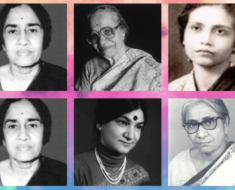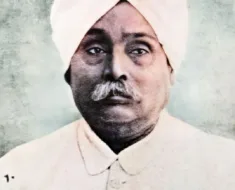Bhikaiji Rustom Cama was an Indian political activist and advocate for women’s rights. She was one of the prominent figures in the Indian independence movement.
She played a very important role in the early days of India’s struggle for Independence.
Bhikaiji Cama was a pre-eminent figure in communicating and propagating the idea of the Indian freedom struggle on the world stage.
And Madam Cama did it with great conviction and courage.
She unfurled the first version of the Indian national flag at the International Socialist Congress held at Stuttgart, Germany, in 1907 and said
“This is the flag of independent India. I appeal to all gentlemen to stand and salute the Flag.”
All the representatives at the conference stood up and saluted the first flag of Independent India.
Madam Cama wanted to bring the attention of the international community to the atrocities, oppression, slavery, and starvation under British imperialism.
And she did succeed in her objective.
“This flag is of Indian Independence! Behold, it is born! It has been made sacred by the blood of young Indians who sacrificed their lives. I call upon you, gentlemen to rise and salute this flag of Indian Independence. In the name of this flag, I appeal to lovers of freedom all over the world to support this flag.” — Bhikaiji Cama , Stuttgart, Germany, 1907
Personal Life – Education and Marriage

Bhikaiji Cama was born on 24 September 1861 in Bombay (now Mumbai) India in a well-off Parsi family. Her parents Sorabji Framji Patel and Jaijibai Sorabji Patel were well-known people in Bombay.
Her father was a lawyer and an influential member of the Parsi community.
He was a famous merchant and was involved in education and philanthropy in the city of Bombay.
Bhikaiji attended Alexandra Girls English Institution and was a much-disciplined child with a great interest in languages.
Madame Came married to Rustom Cama on 3 Aug 1885.
Rustom Cama was an established lawyer and a rich man. He was the son of K.R. Cama an acclaimed Parsi scholar and reformer from Bombay.
Rustomji Cama was pro-British and admired them that they had done a lot of good things for India. Madame Cama believed that Britishers are exploiting India for their own good and profit.
She was a true Nationalist and her involvement with sociopolitical issues led to differences between them. It was not a cordial marriage.
She spent most of her time and energy in philanthropic activities and social work.
Bhikaiji Cama Volunteer Work
Bombay Presidency was hit by famine and then bubonic plague in Oct 1896.
Madame Cama volunteered herself to provide care for the patients at Grant Medical College. And she tirelessly worked to help people suffering from the plague.
During her services, she herself contracted the plague and became severely weak and ill.
Though she recovered from the illness but the disease had an adverse effect on her health.
Doctors in India advised her to go to England for treatment. She went to Britain for medical care in 1902.
Freedom Struggle and Activism

In London, she met Dadabhai Naoroji who was against the British economic policy and was a staunch critic of the same.
He was the President of the British Committee of the Indian National Congress. Bhikaiji Cama started working as his private secretary in 1905 and with him, she started work for Indian National Congress.
Madam Cama was greatly influenced by the views of Mazzini, the great Italian Revolutionary leader.
She came in contact with other Indian nationalists like Shyamji Krishna Varma, Lala Har Dayal, Sardar Singh Rewabhai Rana, and Vir Savarkar in London.
She openly started delivering fiery speeches in support of India’s freedom struggle in London Hyde Park. Indian immigrants in London started supporting her ideology.
Madame Cama along with Dadabhai Naoroji and Rewabhai Rana helped and supported the founding of Shyamji Krishna Varma’s Indian Home Rule Society in Feb 1905.
Bhikhaiji Cama passionately supported gender equality and often talked about the role of women in building a nation. Speaking at National Conference in Cairo, Egypt in 1910, she asked,
“I see here the representatives of only half the population of Egypt. May I ask where is the other half? Sons of Egypt, where are the daughters of Egypt? Where are your mothers and sisters? Your wives and daughters?”
When First World War broke out in 1914, Bhikaiji took an anti-British stand. She visited the army camp at Marseilles and asked the Indian forces (Punjab Regiment Troops) there,
“Are you going to fight for the people who have chained your motherland?”
During the war France and England were allies and she was asked to live outside Paris and to report to the police station once a week.
Undeterred by all this, she continued her activities and struggle for independence. She kept on working with Indian, Irish, and Egyptian revolutionaries as well as with French Socialists and Russian leadership.
Read More: Sarojini Naidu – ‘The Nightingale of India’
The First Lady to Hoist India’s Flag on Foreign Soil

Madame Cama attended the Second Socialist Congress at Stuttgart, Germany on 22 Aug 1907.
She described the devastating effects of the famine that struck the Indian subcontinent. She further appealed for human rights, equality, and autonomy from Great Britain.
Madame Cama unfurled what she called the “Flag of Indian Independence”.
This flag was designed by her and Vinayak Damodar Savarkar. It served as one of the templates from which the current national flag was created.
In the flag, the top green stripe had eight blooming lotuses representing pre-independence India’s eight provinces.
‘Bande Mataram’ was written across the central saffron stripe in Hindi.
On the bottom red stripe, a half moon was on the right and the rising sun was on the left, indicating the Hindu and Muslim faith.
The same flag was later smuggled into India by socialist leader Indu Lal Yagnik. It is now on display at the Maratha and Kesari Library in Pune.
Read More: Siachen Glacier – The Highest Battle Ground on Earth
Bhikaiji Cama Exile in Europe
Madame Cama remained in exile in Europe until 1935.
During her stay in London, she was told that her return to India would be prevented unless she would sign a statement promising that she will not participate in any nationalist activities. She refused to sign and relocated to Paris.
In Paris, she with Sardar Singh Rewabhai Rana and Munchershah Buriorji Godrej founded the Paris India Society.
In Paris, Madame Cama published and distributed revolutionary literature and Nationalist publications like Bande Mataram and Madan’s Talwar (later The Talwar).
These weeklies were smuggled into India through the French colony, Pondichery.
The British govt requested the French govt for Madame Cama’s extradition but they refused it and in return, the Britishers seized Cama’s inheritance.
Even Lenin invited her to reside in the Soviet Union but she did not accept the invitation.
Read More: India Gate – Iconic Symbol of Patriotism
Death

She became ill and paralyzed by a stroke and filed a petition to the British Govt. to allow her to return to India as she was not in a condition to participate in the freedom struggle.
She returned to India in Nov 1935. Having fulfilled her desire of seeing her motherland once again, she breathed her last nine months later on August 13, 1936, at the age of 75.
The nation had lost a fearless leader.
She donated most of her personal assets to the Avabai Petit Orphanage for Girls.
Read More: Statue of Unity – Tallest Statue in the World
Madam Bhikaiji Cama: Legacy
Madam Bhikaiji Cama had a mythical reputation. Indians referred to her as the Mother of the Indian Revolution.
The Russians called her India’s Joan of Arc
On the occasion of India’s 11 Republic Day, 26 Jan 1962, the Indian Posts and Telegraphs Department issued a commemorative stamp in her honour.
A high-rise office complex in South Delhi is named Bhikaiji Cama Place to tribute her.
The India Coast Guard commissioned Priyadarshini-class fast patrol vessel ICGS Bhikaiji Cama after her in 1997.




